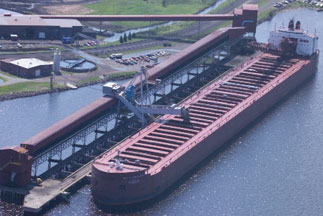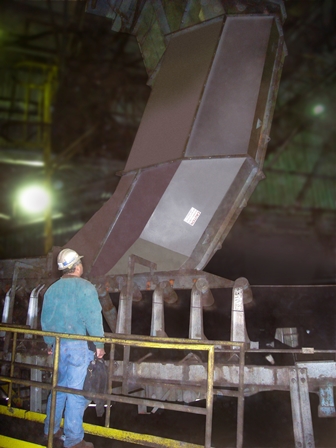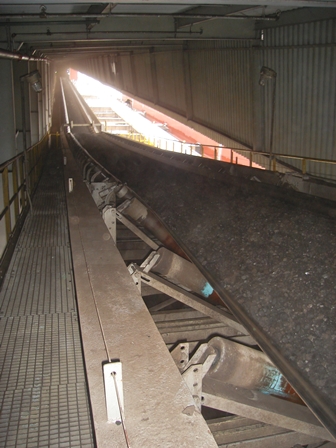Published: August 2nd 2016

At the western end of Lake Superior is a high-volume coal transshipment terminal that’s critical to the North American power industry’s reliance on PRB coal. Superior Midwest Energy Terminal handles approximately 22 million tons of western coal annually, unloading unit trains that bring the coal from mines in the Powder River Basin and transfer it onto massive ships for transportation to utility power plants in the U.S. and Canada. Located on a 200-acre site at the mouth of the St. Louis River in Superior, Wisconsin, the 30 year-old facility has become one of the largest coal handling terminals in the world.
When company officials wanted to upgrade the material handling system to improve throughput and eliminate occasional transfer chute flow issues, they knew it was going to take some creative thinking, as the terminal’s ambitious loading schedule limits the opportunities for maintenance and equipment changes. Downtime is scarce, with maintenance and system upgrades handled during annual mid-January and February system maintenance outages.
The Facility
The Superior Midwest facility is the largest-capacity coal terminal in the industry with only one single-car railcar dumper, according to Fred Shusterich, President of Midwest Energy Resources Company (MERC), a DTE Energy Company that owns and operates the terminal. “We put more coal through that single-car dumper than any operation in the world,” he said.
To receive its coal, the terminal unloads over 1400 trains each year from the BNSF and Union Pacific railway lines. “We unload railcars at 5000 tons per hour,” explained Marshall Elder, Director of Terminal Operations. “That’s roughly 45 cars an hour, or a full 123-car train in about three hours.” The terminal then loads the coal onto approximately 450 vessels during a 305-day shipping season, which runs from late March until mid-January, when ice closes the Wisconsin port.
“We do load some smaller vessels, and a fraction of the coal is moved by truck to taconite processing plants on the Minnesota Iron Range and other local customers, but we are really all about loading ‘super-laker’ vessels for downlake power plants,” said Elder. The 1000-foot long ‘super-laker’-class ships receive from 60,000 to 70,000 tons of coal, depending on lake water levels. Superior Midwest Energy typically loads that cargo in about eight hours. “We can load a vessel at 11,500 tons (10,400 metric tons) per hour,” Elder observed.
Approximately nine million tons of coal – roughly 40 percent of coal handled annually at the terminal – is bound for Detroit Edison power plants, while the rest is carried to utilities in the Midwestern USA and Canada. The terminal’s stockpile system allows the storage and reclaim of up to eight types of coal. A selective reclaim system incorporating rotary plow feeders under the stockpile blends up to three coals into any one cargo, to match the specifications of each customer.
Moving this high volume of four-inch minus PRB coal requires a system of large, high-speed belt conveyors. The terminal uses 60-inch (1.5 m) belts in railcar unloading and 96 inch (2.4 m) belts for vessel loading. All conveyors use steel cable belts with vulcanized splices and operate at 950 feet per minute (5 m/sec).

The Challenges
The goals for a material handling system upgrade were to improve handling efficiency and better control fugitive material. Although plugging of transfer chutes was a rare occurrence, the occasional blockage would impact throughput and cause a significant maintenance issue.
“When we used to plug a chute, the material would spill onto the floor and around the conveyor idlers,” Elder explained. “And at material rates of 11,500 tons per hour, it doesn’t take long to put a lot of material outside the chute. That’s a lot of spilled coal, and a lot of man-hours to clean it up,” he said.
“We sometimes load three ships a day during the operating season, loading vessels around the clock, so it’s difficult to find time to make changes to our system. We cannot keep vessels -- and our customers -- waiting for coal while we make changes to our equipment. Our schedule is such that system availability is crucial, so we need highly efficient and reliable material handling operations to meet our goals.”
“When we are running, we need all systems to work without problems to the extent possible,” Elder continued. “So we can’t afford for any system to go down for any appreciable amount of time. We minimize downtime through reliability maintenance and planning, and by maintaining a full complement of critical spare parts. For example, in January 2008, we replaced the barrel of our car dumper. We then stored the old barrel as a spare in the event of a major failure, because lead time for a new replacement barrel currently approaches one year. The old barrel has about 30% of its predicted useful life left, which makes it a viable spare.”
A Custom-Engineered Solution
The facility’s emphasis on performance and reliability led the terminal to install custom-engineered chutes supplied by Martin Engineering of Neponset, Illinois. Engineered specifically for the materials and flow rate at the Superior Midwest Energy Terminal, the Martin® Inertial Flow™ Transfers are designed to control fugitive material and minimize plugging issues.
“MERC is a high volume operation,” emphasized Shusterich. “And because of that fact, we need to be the best. We aim high and continually make the investments to maintain peak performance levels of our primary coal-handling operations.”
To improve conveyor performance and better control material flow, Superior Midwest commissioned engineered transfer chutes for two belt-to-belt transfers in the terminal. One chute was installed in Junction Tower #1, which connects Conveyor #3 (the tunnel belt under the reclaim) to Conveyor #4 (the transfer belt over the terminal’s rail system). A second engineered chute was installed in Junction Tower #2, which is the transfer tower connecting Conveyor #4 to Conveyor #5 (the dockside conveyor).
The engineered chutes guide the flow of coal from Conveyor 4 down a nearly 26-foot (7.9 meter) drop onto the receiving belt, Conveyor #5. To withstand the abuse of the high volume of material moving through them, the transfer chutes at the Superior Midwest terminal are lined with ceramic tiles. The entire installation was completed during a scheduled winter outage.
Martin® Inertial Flow™ Transfer Technology combines a set of proven components into an engineered system to smooth out the material path and minimize fugitive dust, reducing the possibility of blockages and spillage at conveyor transfer points. Each transfer chute is tailored for the individual application and modeled in 3-D to provide the optimum design for the material and flow rate required.
Inside each chute, a “hood” controls the flow of material from the discharging conveyor, maintaining a coherent material stream and minimizing induced air. At the bottom, a smoothline transfer loading chute or “spoon” directs the stream of material onto the receiving belt at the proper speed and angle, with minimal impact, which reduces material degradation, belt abrasion and airborne dust.
Using this “hood and spoon” design, the chutes deposit the cargo onto the receiving belt at the proper speed and direction of travel. The new chutes help to stabilize the material flow rate and reduce cleanup / maintenance expenses, while controlling the risk of explosion and fire in coal handling operations. Reducing cleanup also helps minimize the risk of injury while working around moving conveyors.
The engineered chute project for Superior Midwest Energy Terminal took approximately nine months from initial discussions until project completion. The contract allowed time for the engineering and fabrication of the chutes, in order to be ready for installation during the terminal’s winter shutdown. Actual installation time for the chutes was just four weeks.
Martin Engineering provided the engineered chutes as a turnkey system, including engineering, fabrication and installation. “That was a big benefit for the terminal,” recalled Elder. “We could devote our time and resources to other systems during our limited outage period.”

“Martin Engineering’s team proved excellent to work with,” Elder continued. “The crew leader and workers were very detail-oriented, and they stayed with the job to resolve any last-minute adjustments that needed to be made. We had some trouble with a diverter gate inside the chutes that was supposed to divert coal to an alternate conveyor. The diverter wouldn’t function as it was designed, and Martin Engineering stepped up to the plate to resolve that problem,” Elder said.
The terminal is anticipating another benefit from the chutes: longer belt life. “That’s one of the key reasons we went to the engineered chutes,” Elder explained. We anticipate getting seven or eight years of service out of our major belts or 175 to 200 million tons of throughput. We monitor the conveyor belt top cover, which will ultimately determine when the belts will be replaced. With the new chutes, we anticipate an increase in belt life of approximately 40%, primarily because of the reduced abrasion realized with the new chute design.”
“At 96 inches (2.4 m) wide, these steel cable belts represent a significant expense,” he continued. “If the engineered chutes let us extend the life of the belting another couple of years, that’s a very positive impact on the cost of maintaining our systems.”
The success of the first two transfer chutes led Superior Midwest to return to Martin Engineering the following winter for another engineered chute. This one was installed on the transfer between Conveyor 5 (the dockside belt) and the shiploading boom conveyor. The dockside conveyor is a tripper belt that allows the conveyor boom to travel along the length of dock, filling the compartments of the self-unloading vessels. The terminal hopes to extend the life of the belt on the short loader conveyor by another 30 to 40 percent.
“The flow-engineered chute technology provides some obvious advantages,” Elder concluded. “I don’t know why any new facility design would incorporate anything else.” Martin® Inertial Flow™ Transfer Technology chutes can be easily be designed into new conveyor systems or retrofitted into an existing material handling operation.
The performance of the Martin® Inertial Flow™ Transfer is helping Superior Midwest maintain its efficiency. Shusterich added, “We pride ourselves on our volume of material handled, and our dependability. We know it’s more than western coal we’re delivering. We’re providing power to communities, so we need to be consistent, available and efficient. The engineered chutes from Martin Engineering help make that possible.”